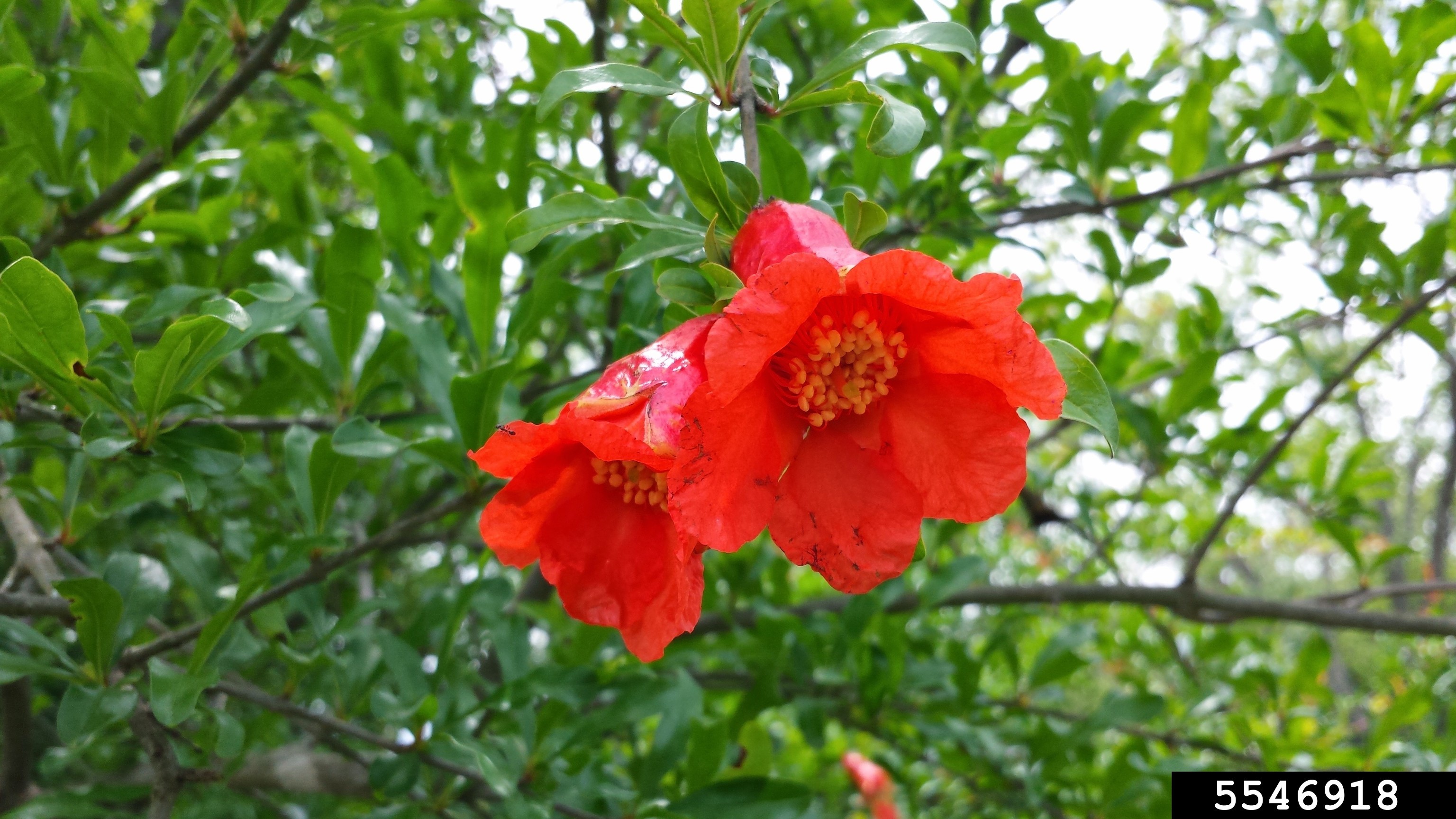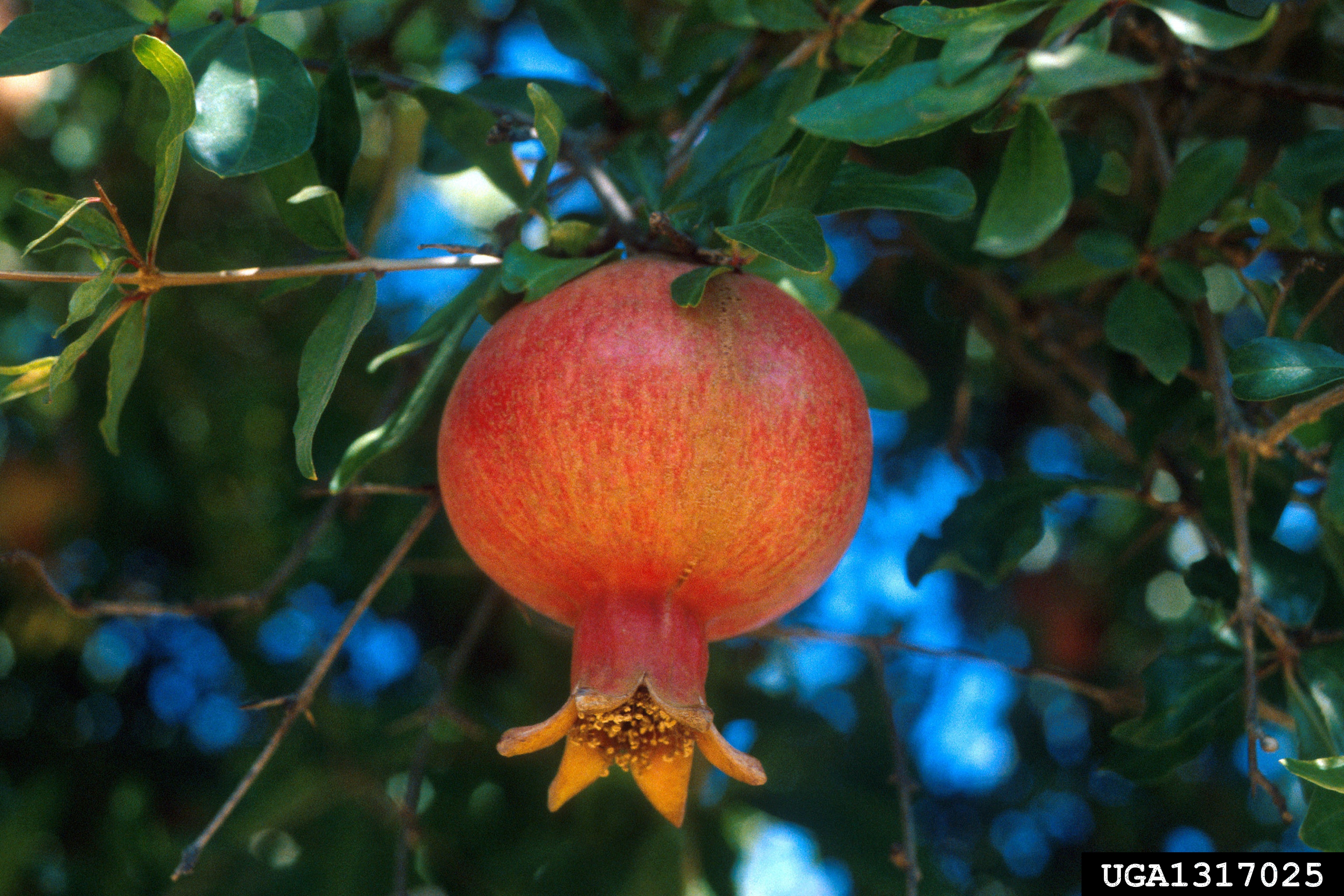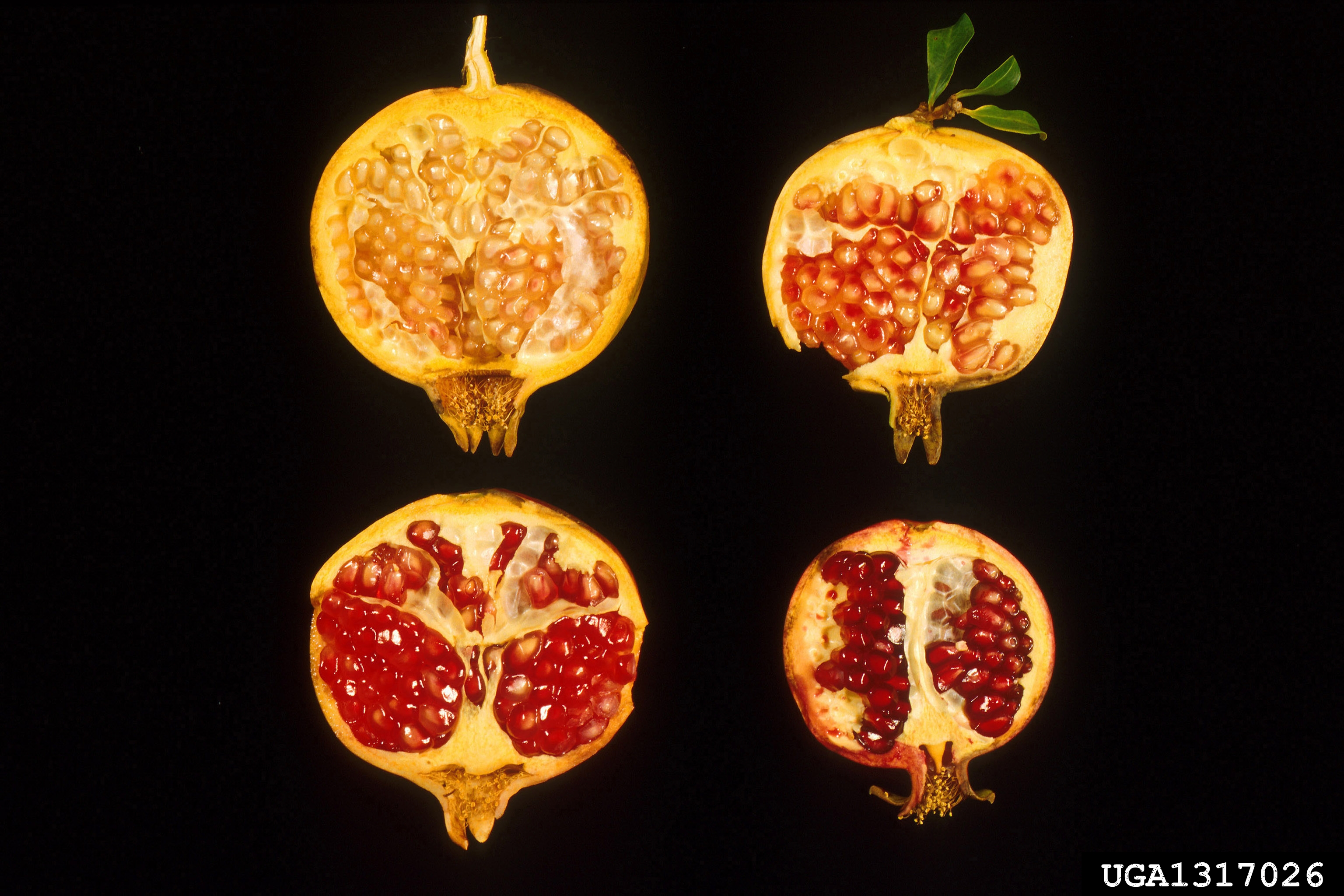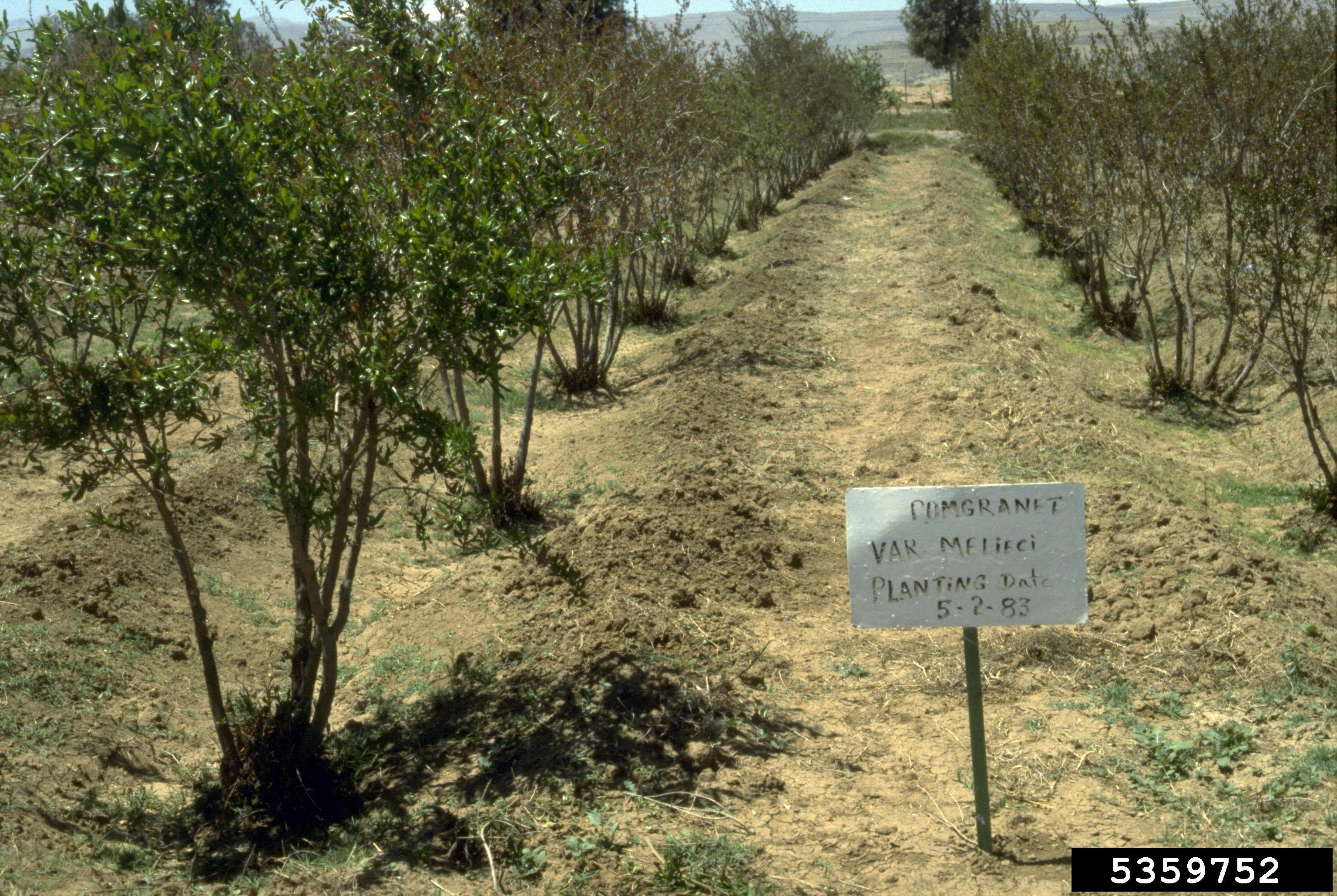 Growing Pomegranates - November 25, 2020 Jeff Schalau, Agent, Agriculture & Natural Resources University of Arizona Cooperative Extension, Yavapai County Pomegranates (Punica granatum) are native to southeastern Europe and Asia and have been cultivated in ancient Egypt, Babylonia, India, and Iran. The Spanish brought them to Mexico, California, and Arizona in the 16th century. Pomegranates have recently gained popularity for their antioxidant content and pulmonary benefits. The pomegranate plant is also very attractive making it worthy of a place in your backyard garden. Pomegranates are easy to grow, have beautiful flowers, are well suited to our desert environment, and have the added benefit of producing delicious fruit. The fruit has flesh-covered seeds (called arils) can be used as a garnish in fruit cups, salads, desserts, and as a snack. The juice is used in making jellies, puddings, desserts, wine and fruit drinks. Grenadine, made from pomegranate juice, is indispensable in flavoring some beverages. Pomegranates grow on woody plants that more closely resemble shrubs than trees. Mature plants are usually 6 to 12 feet in height and can be trained to a tree form. Pomegranate plants are deciduous, have small oval leaves, and are somewhat thorny making them excellent for use as a hedgerow. They require full sun, tolerate alkaline soils, summer heat, and winter lows to 10 degrees F. If you are in a very cold location, you might want to grow them with frost protection or thermal mass nearby. They are somewhat drought tolerant but should be irrigated like other fruit trees for optimum fruit quality. Pomegranate flowers are bright orange, large, and profuse. These develop into mature fruits which are 2 to 5 inches in diameter, have purple to reddish skin (some varieties are pink), which contain hundreds of seeds. The fruits resemble apples but are actually berries and ripen between September and December. Inside the tough outer skin are seeds, each surrounded by a membrane that encloses a juicy pulp: this is the edible portion of the fruit. The juice is somewhat tart and the seed has a slight nutty flavor. Pomegranates are often juiced and are sometimes used to make jelly. Handle pomegranate fruit carefully as they bruise easily. Properly stored fruit will retain its freshness and flavor over an extended period. Harvested fruit should be stored in a cool area (40-50 degrees F). Ripening will continue to full flavor at these temperatures. Fruit stored at 32-40 degrees F will keep for weeks/months, especially at high relative humidity (80% or greater). Pomegranates may be available from nurseries, but you may need to call around to locate them. They can also be ordered from bare root growers in California. There over 500 named varieties of pomegranates, but not all are suitable for growing in north central Arizona. Some cold hardy varieties you might consider include: A.C. Sweet, Kashmir Blend, Parfianka, Sharp Velvet, and others. There are also flowering varieties available which produce small, inedible fruit. Pomegranate cuttings also root readily if you know of a well-adapted, productive plant in your neighborhood. As stated above, pomegranates often have a shrubby growth form. This is because they produce many suckers from the root and crown area. If a shrub-type plant is preferred, leave five or six main shoots. Plants trained to multiple trunks require less frequent care and pruning and come into bearing sooner than plants with only one trunk. To encourage a tree-like form, you can select one trunk and will need to remove suckers on a regular basis. Height and shape can be easily maintained with summer pruning. Pomegranates are self-fruitful, so a second tree is unnecessary for pollination. Severe fruit drop during the plant's juvenile period (3-5 years) is not uncommon. Mature trees seem to set and hold fruit better than younger trees. Once established, a very light application of nitrogen fertilizer in the spring can enhance fruit quality and plant vigor. Pomegranates also have other uses. For instance, a red dye can be extracted from the flowers, a yellow dye from the skin of the fruit, and a black dye from the roots. The wood is also very hard, close-grained, and durable. The plant also contains several alkaloids and tannins in the bark and roots and has been used medicinally for more than 3,000 years. See the on-line edition (URL below) for additional information about pomegranates. You can follow the Backyard Gardener on Twitter – use the link on the BYG website. If you have other gardening questions, email the Master Gardener Help Desk in Prescott (prescottmg@gmail.com) or Camp Verde (verdevalleymg@gmail.com) and be sure to include your name, location, and phone number. Find past Backyard Gardener columns or provide feedback at the Backyard Gardener web site: https://cals.arizona.edu/yavapai/anr/hort/byg/. Images  Pomegranate flower (Photo by Rebekah D. Wallace, University of Georgia, Bugwood.org).
Pomegranate flower (Photo by Rebekah D. Wallace, University of Georgia, Bugwood.org). Pomegranate fruit (Photo by USDA ARS Photo Unit, USDA Agricultural Research Service, Bugwood.org).
Pomegranate fruit (Photo by USDA ARS Photo Unit, USDA Agricultural Research Service, Bugwood.org). Pomegranate arils showing different varieties and their color variation (Photo by USDA ARS Photo Unit, USDA Agricultural Research Service, Bugwood.org).
Pomegranate arils showing different varieties and their color variation (Photo by USDA ARS Photo Unit, USDA Agricultural Research Service, Bugwood.org). Irrigated pomegranate orchard in Yeman (Photo by William M. Brown Jr., Bugwood.org).
Irrigated pomegranate orchard in Yeman (Photo by William M. Brown Jr., Bugwood.org).Additional Resources Pomegranates, University of Arizona extension.arizona.edu/pomegranates Pomegranate Production Information and More, University of California Agriculture and Natural Resources ucanr.edu/sites/Pomegranates/ How to Use Pomegranates as a Healthy Choice, Utah State University extension.usu.edu/news_sections/home_family_and_food/pomegranates Pomegranate Varieties Available from Dave Wilson Nursery, Hickman, CA, This is not an endorsement, however some northern Arizona nurseries order bare root trees each spring from this vendor. www.davewilson.com/product-information/product/pomegranates |